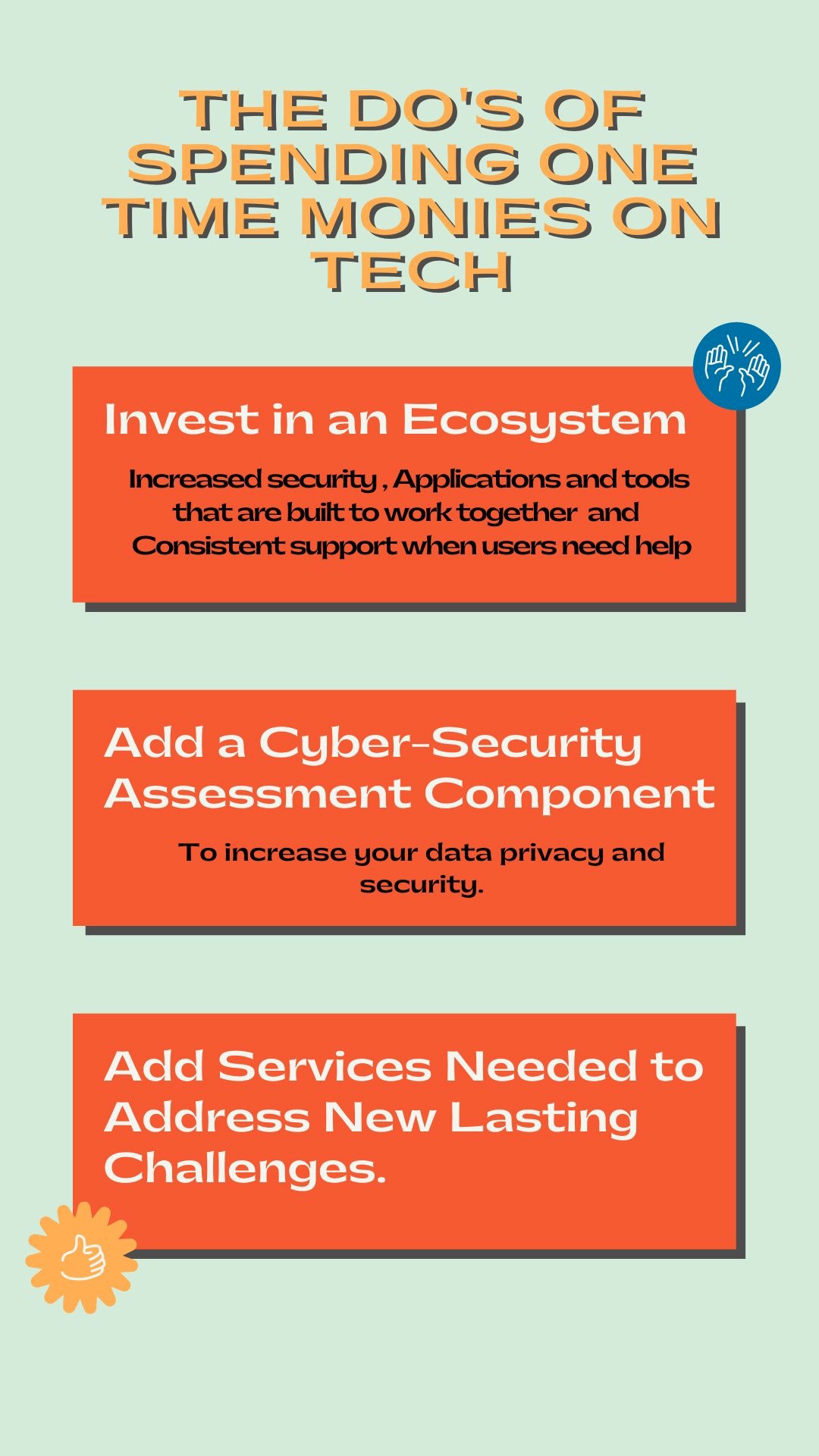Do’s and Don'ts with One-Time Funds
Strategic use of one-time funds can go a long way in a school district

These are truly unprecedented times.
The challenges of COVID-19 continue to compel creativity, innovation, and a relentless focus on serving our students, families, and communities. In addition to the pressing health and safety challenges that we experience every day, we are also undergoing dramatic shifts in funding as a result of rising unemployment, reduced tax collections, and migration and mobility like we have never seen before.
Now that we are approaching the end of 2020, we are seeing that large states projecting notable infusions of one-time dollars for 2021-22. For example, California’s anticipated revenues were reduced for the 2020-21 fiscal year when unemployment rates soared beyond 15%, but a rebound of the three major revenue sources (sales tax, personal income tax, and corporate tax) has resulted in a prediction of a large influx in 2021-22. However, that leads to a potential “financial cliff” in 2022-23.
In addition, any potential federal stimulus package, with earmarks for school districts, will provide more one-time funds in the coming months.
Professional Learning
Investing in your team is always a good use of resources and particularly wise utilization of one-time funds. Given the reality that we are navigating through a global pandemic, there is also no shortage of potential focus areas for professional learning. We suggest a review of your strategic framework, including the vision, mission, values, and goals to ensure that professional learning plans are aligned with the aspirations of the organization. In addition, we strongly advise you to design and implement professional learning experiences that are ongoing, collaborative, and relevant, and that create opportunities for reflection and sharing.
One-time funds are also often a way to expand professional learning opportunities for groups of employees who may not traditionally have as much access. For example, in California, many teachers have dedicated time in their contracts for professional development, yet it is scarce to find the same provisions in classified employee agreements. Devoting one-time resources to provide meaningful learning options for instructional aides, for example, is very likely to yield immediate results for students and also have an enduring impact. Depending on the flexibility of the funding source, finding ways to involve office staff, custodians, facilities and maintenance, food services, library, purchasing, finance, payroll, human resources, and other constituencies in the professional learning community also builds collaborative relationships, generates social capital, and improves team connectedness.
Tech Infrastructure and Hardware
Technology has become the go-to source for keeping schools open and students connected to not only content but also to one another. The priorities in spending for technologies are dependent on the infrastructure in place within the district. A recent report written by each of the former Education Technology Directors of the U.S. Department of Education highlighted ten ways to make online learning work and at the top of the list was connecting all learners. Infrastructure and device deployment can be a capital expense, but getting the ball rolling could be a good use of one-time funds, provided you have the capital or local funds to keep up the momentum.
Tech & Learning Newsletter
Tools and ideas to transform education. Sign up below.
Beyond devices, digital content, professional learning, assessment solutions, and learning platforms are each beneficial and necessary aspects of any successful digital-rich learning plan. One-time funds are great kickstarters to long-term technology plans.
One thing to pay attention to when procuring technology with one-time funds is the recurring costs associated with licenses or other fees. Be sure to note in procurement which funds will be used for recurring costs versus one-time expenses.
For example, purchasing a device is a one-time cost but adding technical support or loss prevention software is a recurring expense. These can be itemized and delineated in a budget sheet so that your spending is from two different sources. This also applies to learning platforms and digital content licenses. You can use the one-time spend to pay for professional learning or server/cloud setup fees but the license fees should be a line item within your local budget.

Safety & Facility Improvements
School buildings across the nation were in trouble even before COVID-19 with many aging facilities needing repairs and safety support, especially in low-income communities. Leaky roofs, mold and mildew, rusty plumbing, and outdated heating and cooling systems have further compounded the challenges in a pandemic era during which safety is the No. 1 priority of staff and families.
We suggest looking carefully at one-time funds to address longer-term safety and facility improvements. Really think through current challenges and investments you might be making -- hundreds of thousands of face shields for students and staff will not be needed when the pandemic is over, so are there similar items that could be purchased that would address a long-term need?
Reviewing your facility master plans and deferred maintenance lists is a good starting point that can help to prioritize strategic one-time expenses for building improvements. In addition, investing in solar or other forms of energy efficiency may result in long-term utility savings to provide additional spending flexibility in the future.
Proceed with Caution
As with any one-time funds, there are certain pressures that district leaders will face from bargaining and special interest groups who want additional positions, new programs, or raises for current staff. While the outcome may ease relationships, a key fiscal rule should be at the forefront: Don’t spend one-time dollars on items that eat and breathe.
The intent of the federal relief dollars was just that, as the U.S. Treasury Department has noted. The funds should be used to relieve the impacts of the pandemic, including the resulting fiscal crisis from states and locales where the cost of living adjustments was reduced, programs eliminated, and budgets impacted by the loss of student enrollment.
Prudent use of the funds can help mitigate deficits, declining enrollment, and the safety and security costs of keeping staff and students safe during the pandemic. With carefully designed spending plans, the impacts can be far-reaching.
Bottom line, plan so that any one-time funds can stimulate a long-term spend already included in your local or capital budget. If you currently have money in the local or capital budget for computer refresh, then use these one-time funds to relieve that expense but don’t delete it from the budget. If you already have money in your Title II budget for professional learning, then use these funds to offer professional development not currently included in your course offerings. In general, think of grant or stimulus money as an accelerator and not a sustainer of programs or initiatives.
Lisa Gonzales is the Chief Business Officer in Mt Diablo Unified School District.
Kecia Ray is the President of K20Connect, LLC and Transformation Coach for the South Carolina Department of Education.
Devin Vodicka is the Chief Impact Officer at Altitude Learning, author of Learner-Centered Leadership, and former superintendent of Vista Unified School District
Dr. Ray's career includes designing technology within the Frist Center for the Visual Arts and directing technology research through Vanderbilt University School of Medicine Science Outreach programs. As a district administrator for Metropolitan Nashville Public Schools, she led the award-winning design, implementation, and evaluation of instructional technology programs, including instructional design for online and blended learning environments, redesigning physical learning environments, redefining school libraries, and establishing the first virtual high school to award the diploma. She leads K20Connect and other passion projects supporting K20 education around the world.

